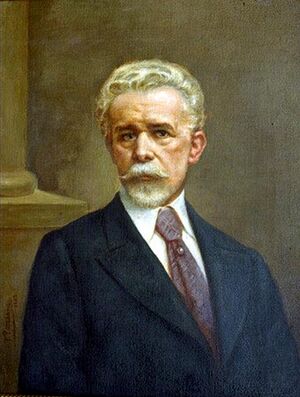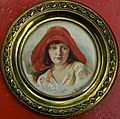Tomás Povedano facts for kids
Tomás Povedano de Arcos (born September 22, 1847, in Lucena, Spain – died February 29, 1943, in San José, Costa Rica) was a talented Spanish painter. He spent most of his life living and working in Costa Rica.
Tomás Povedano studied painting in Málaga and Seville, Spain. While he was a student at the Academy of Fine Arts in Seville, he worked as an illustrator and gave private drawing lessons. He started his art career by decorating fans. Later, he became known for his beautiful paintings of flowers and other symbolic themes.
He was involved in a movement that tried to create the First Spanish Republic. He wrote for newspapers like El Abanderado and El Baluarte. He was also a volunteer soldier and a representative for a political group. Povedano was a Mason and a theosophist, which means he was part of groups that explored spiritual and philosophical ideas.
In 1889, he won a gold medal at the Universal Exhibition in Paris for a full-length portrait. This big win helped him get a job in Ecuador. The government of Ecuador wanted him to create a new art school there.
He arrived in Ecuador in 1892 and founded the Academy of Fine Arts in Cuenca. He also started another one in Guayaquil. During his time in Ecuador, he painted many important portraits for people.
In 1896, Povedano left Ecuador and planned to go to Mexico. However, he stopped in Costa Rica after being invited by the government. The President, Rafael Yglesias Castro, hired him to set up the National School of Fine Arts. This school opened on March 12, 1897, in San José.
Povedano was the director of this art school until 1940. At that time, the school became part of the University of Costa Rica.
He was very impressed by the native people of Costa Rica. Povedano painted pictures that showed their culture, history, art, and looks in an ideal way. He also created many paintings about Costa Rican life, including landscapes and local customs.
In 1926, he was chosen to represent Costa Rica at a big art show in Los Angeles. He also took part in other art exhibitions in Costa Rica. He helped decorate the National Theater with three large oil paintings called Art, Commerce, and Industry.
Povedano painted portraits of several presidents and important families in Costa Rica. One famous portrait is of José María Castro. Povedano also brought watercolor painting to Costa Rica. He was interested in the country's plants, painting orchids and other native flowers.
He also drew pictures for books, like the Silabario castellano by Porfirio Brenes. He illustrated newspapers such as La Tribuna and magazines like Páginas ilustradas and El Fígaro. He also drew for the Historical Booklet of Costa Rica, which was a history textbook used in Costa Rican schools for many years.
Tomás Povedano taught many young Costa Ricans who wanted to become artists. He was a great example of the academic style of painting, which was popular when Costa Rican art was first developing. He worked hard to keep the art school open, even during tough economic times. He was especially good at portraits, landscapes, and decorative paintings.
His artwork received many awards and honors. After he passed away, several important art shows were held to celebrate his work.
Povedano also helped organize the theosophical movement in Costa Rica. He founded the Virya Lodge and directed a magazine with the same name.
He was married twice. First, to Carolina Amores from Spain, and they had two children, María de la Cinta and Diego. Later, he married María Esmeralda Inés de Jesús Loria Rivera from Costa Rica, and they had a daughter named María Elena.
Director of the Fine Arts School
As the director, Povedano taught a traditional style of art called academicism. He did not like the newer art movements that appeared in the late 1800s and early 1900s, such as synthesism, cubism, futurism, and orphism. He once wrote that these new styles were "studies of modern art sickness" and "products of madness." He wondered how they could be accepted by people who thought they were advanced.
An essay about art shows in San José from 1928 to 1937 said that Povedano's School of Fine Arts was "completely against the new trends of the time." The art created there was mostly for wealthy people in society.
Povedano's students learned by copying plaster models and drawings of classical sculptures. They also copied "models from Europe with old-fashioned landscapes." When they painted real things, they mostly focused on portraits and still lifes, like flowers, vegetables, and fruits. Landscapes often showed lakes with swans, which were also considered old-fashioned. Because of this, some people jokingly called Povedano's students "painters of pillows and ribbons." The essay also noted that Costa Rican themes were often missing from their art.
However, everyone agrees that Povedano was a great teacher. He knew how to teach and had a strong understanding of painting techniques. His strict teaching style led to good results for his students.
Art on Money
Several of Povedano's artworks were used as designs for banknotes (paper money) in Costa Rica.
The first banknote to feature his art was a 10-colon bill from 1903, issued by the Anglo Costa Rican Bank. This bill used a charcoal drawing Povedano made of Braulio Carrillo Colina. This portrait became very popular and was used on many other Costa Rican banknotes, including 5-colon bills in the 1940s and 1950s.
Another portrait by Povedano, of José Rafael Gallegos, was chosen for a 1-colon bill in 1917. However, this bill was never actually put into circulation.
Povedano's drawings also influenced the image on the back of a 10-colon National Banknote from 1939. The image of an indigenous chief on the bill looks very similar to a drawing of a Huetar chief that Povedano made for a history book.
In 1938, Povedano drew a pencil portrait of Juan de Cavallón. Three years later, this drawing was used on a 20-colon banknote from the National Bank in 1941.
In the same year, a 2-colon banknote was released. The back of this bill showed a changed version of Povedano's unfinished oil painting called The Rescue of Dulcehé. The engraver who made the bill finished the painting by adding details and changing some parts of the original work.
Gallery
- Presidents
- National Theater
- Other
- Warecolors
- Bills
See also
 In Spanish: Tomás Povedano para niños
In Spanish: Tomás Povedano para niños















